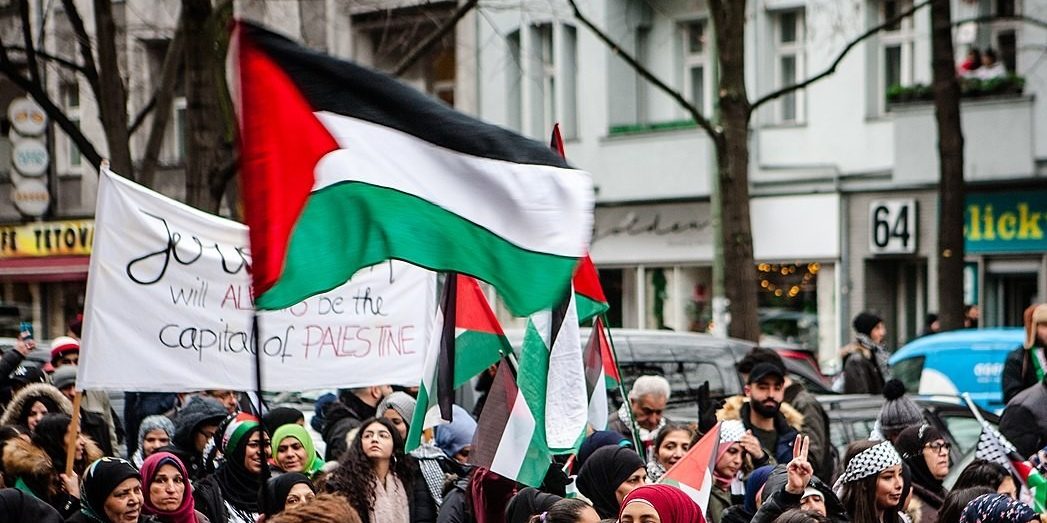What does Gaza have to do with the climate crisis?
On Monday 6 October, having been illegally intercepted and detained by Israeli forces after an attempt break the siege on Gaza, Greta Thunberg and other activists onboard the Sumud Flotilla arrived in Athens.
Despite reports of the activists’ mistreatment under Israeli detention, Thunberg insisted in her first public address since her capture: “[This] is not the story. Let me be very clear: there is a genocide going on in front of our very eyes … We cannot take our eyes away from Gaza, from all the places of the world that are suffering, living on the forefront of this business-as-usual system: Congo, Sudan, Afghanistan, Gaza and many, many more. What we are doing is the bare minimum.”
This is the stance that Thunberg has taken over the past two years since the escalation of Israeli violence in Gaza, declaring at a protest held in Amsterdam in 2023 that “there is no climate justice in occupied land.”
Since when did the strategic murder and starvation of innocent civilians become a point of ‘view’ to squabble and haggle over?
Thunberg’s solidarity with Palestinian liberation has been met with pushback from environmental groups and mainstream media alike (though there is little surprise to be found regarding the latter). In 2023, one publication released by Der Speigel describes the righteous rage of Erjan Dam of the Netherlands, who accuses Thunberg of sowing “disunity” at the protest by leveraging her platform for politics. Dam snatched the microphone and declared “I came here for a climate demonstration, not a political view.”
I remember watching a clip of this instance not long after it had happened in 2023 and feeling baffled at the stance – the climate movement was nothing but political! Also, since when did the strategic murder and starvation of innocent civilians become a point of ‘view’ to squabble and haggle over? What was the point of saving the environment if not firstly for people?
Yet, funnily enough for Dam, speaking on the ground level of Gaza, the carpet bombing of homes, hospitals, schools, leaving behind more than 40 million tonnes of debris and hazardous waste, while implementing the destruction of over 80% of Gaza’s trees, is without a doubt enough of an environmental concern alone. But this barely scratches the surface of the question of environmental justice.
In April 2025, Professor Paul Rogers from the University of Bradford estimated in an interview with journalist and political activist Owen Jones, that a total of 70,000 tonnes of explosives have been dropped on Gaza. To put into perspective, this is roughly the weight of 350 blue whales.
It is necessary that we complicate our understanding of environmental violence from the melting of ice packs to the concrete jungle of office complexes
To imagine the environmental destruction and humanitarian suffering that this scale of bombardment must have caused is one thing, but to consider the aggressive extraction required to mine enough raw materials to manufacture the weight of 350 adult blue whales in weaponry from the earth? This complicates the problem of environmental and climate justice beyond the symptoms of greenhouse gasses or the levelling of fertile land in Gaza.
When we move to consider what must have occurred to enable such devastation, we begin to trace the bloody line of extraction and exploitation that had brought the bombs to the hands of Netanyahu’s administration and the colonial histories that have facilitated its realisation.
In an infographic released by the Campaign Against Arms Trade (CAAT), the value of UK parts in F-35 delivered to Israel has been estimated to be at least £336 million. Directly outside the arms manufacturing complex lies the support of various UK-based financial institutions. In a report led by PAX, UK based banks – Barclays, Lloyds, HSBC, Standard Chartered, and NatWest – each provided some form of loaning and underwriting services to the six most involved weaponry suppliers to Israel.
In her book, Dark Laboratory, Dr Tao Leigh Goffe highlights the ways in which environmental extraction, race, and colonial exploitation compounded and reverberated into our present from the plantations of the 16th century. Placing the environment within the realm of race and colonial extraction, she describes the climate crisis as a kind of self-cannibalism under the system of capitalist economic growth, born from the exploitation of those deemed disposable.
This cannibalism has grown with us from the plantation. It is the same force that enables the endless extraction of minerals from the Global South, the same that enables and supports the occupation of Palestine, as well as arrests those who dissent genocide as terrorists.
It is necessary that we complicate our understanding of environmental violence from the melting of ice packs to the concrete jungle of office complexes, then further to the gaping orifices of cobalt mines and the explosions in Gaza and beyond. This is what lies behind Thunberg’s statement that “there is no climate justice on occupied land.”

Comments